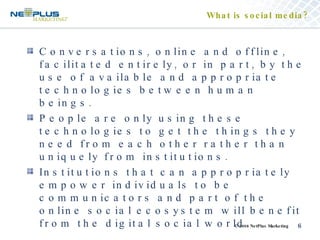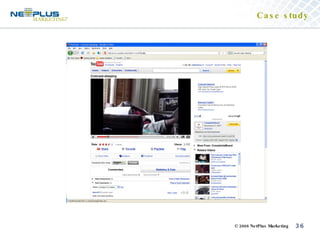Social Media Workshop
- 1. Social Media Workshop January 30, 2009
- 2. Agenda What is social media Look who’s talking now… It’s all about the dialogue, or is it? Why conversations aren’t marketing Planning a social media program Profiling tool Objectives and strategy Technology and measurement Social media mapping Join the conversation Case studies Lab
- 3. What is social media?
- 4. What is social media? A category of sites that is based on user participation and user-generated content. The term social media describes media that is posed by the user and can take many different forms. Software tools that allow groups to generate content and engage in peer-to-peer conversations and exchange of content. Online technologies and practices that people use to share opinions, insights, experiences, and perspectives with each other.
- 5. What is social media? “ Social media are primarily Internet and mobile-based tools for sharing and discussing information among human beings. The term most often refers to activities that integrate technology, telecommunications and social interaction, and the construction of words, pictures, videos and audio. This interaction, and the manner in which information is presented, depends on the varied perspectives and "building" of shared meaning among communities, as people share their stories and experiences.” -Wikipedia
- 6. What is social media? Conversations, online and offline, facilitated entirely, or in part, by the use of available and appropriate technologies between human beings. People are only using these technologies to get the things they need from each other rather than uniquely from institutions. Institutions that can appropriately empower individuals to be communicators and part of the online social ecosystem will benefit from the digital social world.
- 7. Look who’s talking now… People are talking to each other Customers are blogging about companies Consumers are reviewing products People are re-posting commercials on YouTube Groups are forces on Facebook Enthusiasts define companies on Wikipedia News now travels at the speed of ‘Twitter’
- 8. Conversations are not marketing But markets are conversations… How we learn and develop understanding 1 st person = Experience 2 nd person = Conversations 3 rd person = Media
- 9. Conversations are not marketing
- 10. Conversations are not marketing
- 11. Conversations are not marketing
- 12. Conversations are not marketing
- 13. Conversations are not marketing
- 14. Conversations are not marketing In a “conversation era”… 1 st person The experience 2 nd person Relationships matter Trust Transparency Authenticity Intentions 3 rd person Media connects with market and service community
- 15. Conversations are not marketing
- 16. Conversations are not marketing Markets are conversations. Markets consist of human beings, not demographic sectors. Conversations among human beings sound human. They are conducted in a human voice. Whether delivering information, opinions, perspectives, dissenting arguments or humorous asides, the human voice is typically open, natural, uncontrived. People recognize each other as such from the sound of this voice. The Internet is enabling conversations among human beings that were simply not possible in the era of mass media. Cluetrain Manifesto (Thesis 1-6)
- 17. Planning a social media program People Understand your audience and where they are active College students? Social networks Objectives What are you trying to accomplish? How are you going to measure it? Strategy What will be different if we accomplish our goals? Technology Twitter, blog, wiki, social application
- 18. Planning a social media program Types of social media participation Creators Create videos, maintain a blog, Wikipedia editors Critics Review products, rate videos, post experiences Collectors Bookmark content, tag content, share videos Joiners Social networks, groups, forums Spectators View user generated content Inactives
- 19. Planning a social media program Objectives Listening Dialogue Energize and enthuse Supporting Connect and embrace To achieve Awareness Conversions Traffic Buzz New customers
- 20. Planning a social media program Strategy What will be different if we accomplish our goals? A better 2-way relationship with customers More buzz and awareness An effective customer service channel More sales Customer collaboration Customers connected with each other
- 21. Planning a social media program Put everything together and then pick technology
- 22. Planning a social media program Montitoring and measurement Human analysis Google Blog Search, News, and Alerts Yahoo Pipes Twitter Search Technorati Co.mments Blogpulse BoardTracker Keotag Google Analytics Paid tools Radian 6, Nielsen Online, TNS Cymfony, Buzz Gain
- 23. Planning a social media program Metrics and measurement Traffic referred from social media sites Google Analytics, Omniture, etc Conversions and HVTs referred from social sites Google Analytics, Omniture, etc Number of friends and level of discussion Human analysis Growth of new friends over time Friends/discussions Social links and bookmarks AddThis Video viewership TubeMogul Qualitative
- 24. Join the conversation We know some people from your company. They’re pretty cool online. Do you have any more like that you’re hiding? Can they come out and play? When we have questions we turn to each other for answers. If you didn’t have such a tight rein on “your people” maybe they’d be among the people we’d turn to. Cluetrain Manifesto (Thesis 84-85)
- 25. Join the conversation Social media principles Be human Be honest Be aware Be a participant Be smart Be open Be courageous
- 26. Join the conversation Success will happen, but so will failure Experiment Understand how people are using channels Remain authentic and true to your brand Be transparent Creative must be engaging Content is king Be conversational, not “markety” Participate and engage
- 27. Case study
- 28. Case study
- 29. Case study
- 30. Case study
- 31. Case study
- 32. Case study People Theater-goers, students, and fans Objectives Dialogue Energize and enthuse Connect and embrace Strategy Generate awareness and buzz through UGC on high-traffic sites Energize loyal fan base to help spread the word Technology Social networks Video Google Analytics and Blog Search
- 33. Case study
- 34. Case study Results 6.92 page views per session (3.51 average) 5:02 time on site (2:14 average) 21.83% bounce rate (53.02% average) 3x average conversion rate #1 referrer of traffic
- 35. Case study
- 36. Case study
- 37. Case study
- 38. Case study
- 39. Case study
- 40. Case study People Comcast subscribers Objectives Listening Dialogue Supporting Strategy Extend customer service through social media Technology Twitter Blog/GetSatisfaction.com Nielsen Online (formerly Buzz Metrics)
- 41. Case study
- 42. Case study
- 43. Case study
- 44. Case study
- 45. Case study People Zappos customers and fans Objectives Dialogue Supporting Strategy Engage in a dialogue, transparency Extend customer service through social media Technology Twitter
- 46. Questions
- 47. Lab Learn, lurk, review, research…














































